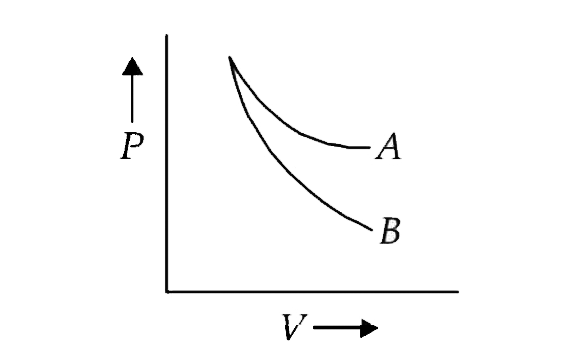Is the equation PV=RT valid for both, isothermal and adiabatic changes?
To determine whether the equation PV=RT is valid for both isothermal and adiabatic changes, we can analyze the definitions and conditions of these processes.
1. Understanding the Equation:
The equation PV=RT is known as the ideal gas law, where:
- P = pressure of the gas,
- V = volume of the gas,
- R = universal gas constant,
- T = absolute temperature of the gas.
2. Isothermal Process:
- An isothermal process occurs at a constant temperature.
- In this case, if the temperature T is constant, the product PV will also remain constant for a given amount of gas (assuming ideal behavior).
- Therefore, the equation PV=nRT (where n is the number of moles) holds true, as long as the temperature remains constant.
3. Adiabatic Process:
- An adiabatic process is characterized by no heat exchange with the surroundings.
- In an adiabatic process, the temperature of the gas can change due to work being done on or by the gas.
- However, the ideal gas law PV=nRT can still be applied at any given state of the gas, even though the relationship between P, V, and T will differ from that in an isothermal process.
4. Conclusion:
- The equation PV=RT is universally valid for any ideal gas, regardless of whether the process is isothermal or adiabatic.
- Thus, we conclude that PV=RT can be used in both isothermal and adiabatic processes.
Final Answer:
Yes, the equation PV=RT is valid for both isothermal and adiabatic changes.
The equation PV=RT is known as the ideal gas law, where:
- P = pressure of the gas,
- V = volume of the gas,
- R = universal gas constant,
- T = absolute temperature of the gas.
- An isothermal process occurs at a constant temperature.
- In this case, if the temperature T is constant, the product PV will also remain constant for a given amount of gas (assuming ideal behavior).
- Therefore, the equation PV=nRT (where n is the number of moles) holds true, as long as the temperature remains constant.
- An adiabatic process is characterized by no heat exchange with the surroundings.
- In an adiabatic process, the temperature of the gas can change due to work being done on or by the gas.
- However, the ideal gas law PV=nRT can still be applied at any given state of the gas, even though the relationship between P, V, and T will differ from that in an isothermal process.
- The equation PV=RT is universally valid for any ideal gas, regardless of whether the process is isothermal or adiabatic.
- Thus, we conclude that PV=RT can be used in both isothermal and adiabatic processes.
Yes, the equation PV=RT is valid for both isothermal and adiabatic changes.
Topper's Solved these Questions
- BOOK - PRADEEPCHAPTER - THERMODYNAMICSEXERCISE - Long answer questions11videos
THERMODYNAMICS
- BOOK - PRADEEPCHAPTER - THERMODYNAMICSEXERCISE - Advanced problems for competitions10videos
THERMODYNAMICS
- BOOK - PRADEEPCHAPTER - THERMODYNAMICSEXERCISE - Very short answer questions31videos
THERMODYNAMICS
- BOOK - PRADEEPCHAPTER - SYSTEMS OF PARTICLES AND ROTATIONAL MOTIONEXERCISE - Assertion- Reason Type questions20videos
SYSTEMS OF PARTICLES AND ROTATIONAL MOTION
- BOOK - PRADEEPCHAPTER - WORK, ENERGY AND POWEREXERCISE - Assertion-Reason Type Questions24videos
WORK, ENERGY AND POWER
Similar Questions
Knowledge Check
- Question 1 - Select One
The slope of isothermal and adiabatic curves are related as
Aisothermal curve slope = adiabatic curve slopeBisothermal curve slope = γ×adiabatic slopeCadiabatic curve slope = γ× isothermal slopeDadiabatic curve slope = (1/2) × isothermal curve slope - Question 2 - Select One
The gas equatioon PV/2=RT, V stands for
Avolume of 2 grams of a gasBvolume of 2 moles of gasCvolume of 1 mole of gasDvolume of 1/2 mole of gas
Reversible Isothermal and Adiabatic process
View SolutionComparison of Isothermal and Adiabatic work
View SolutionAnalysis OF Isothermal and Adiabatic Process
View SolutionThe curves A and B in the figure shown P-V graphs for an isothermal and an adiabatic process for an idea gas. The isothermal process is represented by the curve A.
 View Solution
View SolutionThe gas lawPVT= constant is true for
(A) Isothermal changes only
(B) Adiabatic changes only
(C)Both isothermal and adiabatic changes
(D) Neither isothermal nor adiabatic changes "View SolutionIsothermal Process and Adiabatic Process.
View Solution

